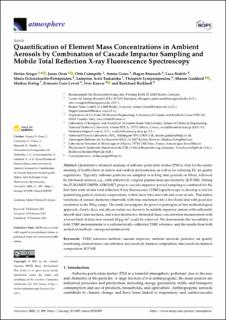| dc.contributor.author | Seeger, Stefan | |
| dc.contributor.author | Osan, Janos | |
| dc.contributor.author | Czömpöly, Ottó | |
| dc.contributor.author | Gross, Armin | |
| dc.contributor.author | Stosnach, Hagen | |
| dc.contributor.author | Stabile, Luca | |
| dc.contributor.author | Ochsenkuehn-Petropoulou, Maria | |
| dc.contributor.author | Tsakanika, Lamprini Areti | |
| dc.contributor.author | Lymperopoulou, Theopisti | |
| dc.contributor.author | Goddard, Sharon | |
| dc.contributor.author | Fiebig, Markus | |
| dc.contributor.author | Gaie-Levrel, Francois | |
| dc.contributor.author | Kayser, Yves | |
| dc.contributor.author | Beckhoff, Burkhard | |
| dc.date.accessioned | 2021-03-24T13:36:14Z | |
| dc.date.available | 2021-03-24T13:36:14Z | |
| dc.date.created | 2021-03-17T10:15:10Z | |
| dc.date.issued | 2021 | |
| dc.identifier.citation | Atmosphere. 2021, 12, 309. | en_US |
| dc.identifier.issn | 2073-4433 | |
| dc.identifier.uri | https://hdl.handle.net/11250/2735319 | |
| dc.description.abstract | Quantitative chemical analysis of airborne particulate matter (PM) is vital for the understanding of health effects in indoor and outdoor environments, as well as for enforcing EU air quality regulations. Typically, airborne particles are sampled over long time periods on filters, followed by lab-based analysis, e.g., with inductively coupled plasma mass spectrometry (ICP-MS). During the EURAMET EMPIR AEROMET project, cascade impactor aerosol sampling is combined for the first time with on-site total reflection X-ray fluorescence (TXRF) spectroscopy to develop a tool for quantifying particle element compositions within short time intervals and even on-site. This makes variations of aerosol chemistry observable with time resolution only a few hours and with good size resolution in the PM10 range. The study investigates the proof of principles of this methodological approach. Acrylic discs and silicon wafers are shown to be suitable impactor carriers with sufficiently smooth and clean surfaces, and a non-destructive elemental mass concentration measurement with a lower limit of detection around 10 pg/m3 could be achieved. We demonstrate the traceability of field TXRF measurements to a radiometrically calibrated TXRF reference, and the results from both analytical methods correspond satisfactorily. | en_US |
| dc.language.iso | eng | en_US |
| dc.rights | Navngivelse 4.0 Internasjonal | * |
| dc.rights.uri | http://creativecommons.org/licenses/by/4.0/deed.no | * |
| dc.title | Quantification of Element Mass Concentrations in Ambient Aerosols by Combination of Cascade Impactor Sampling and Mobile Total Reflection X-ray Fluorescence Spectroscopy | en_US |
| dc.type | Peer reviewed | en_US |
| dc.type | Journal article | en_US |
| dc.description.version | publishedVersion | en_US |
| dc.rights.holder | © 2021 by the authors. Licensee MDPI, Basel, Switzerland. | en_US |
| dc.source.volume | 12 | en_US |
| dc.source.journal | Atmosphere | en_US |
| dc.identifier.doi | 10.3390/atmos12030309 | |
| dc.identifier.cristin | 1898567 | |
| dc.source.articlenumber | 309 | en_US |
| cristin.ispublished | true | |
| cristin.fulltext | original | |
| cristin.qualitycode | 1 | |

